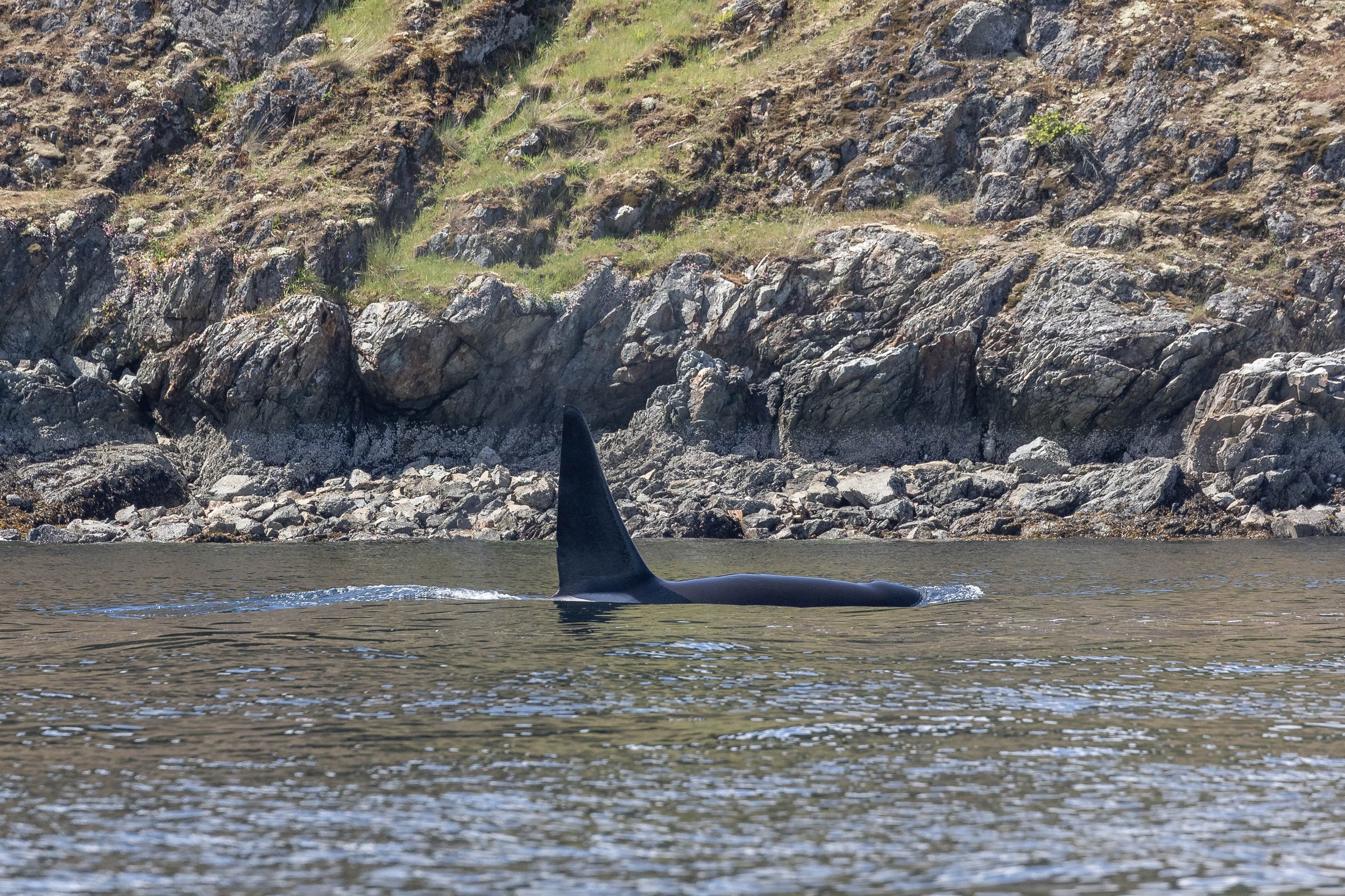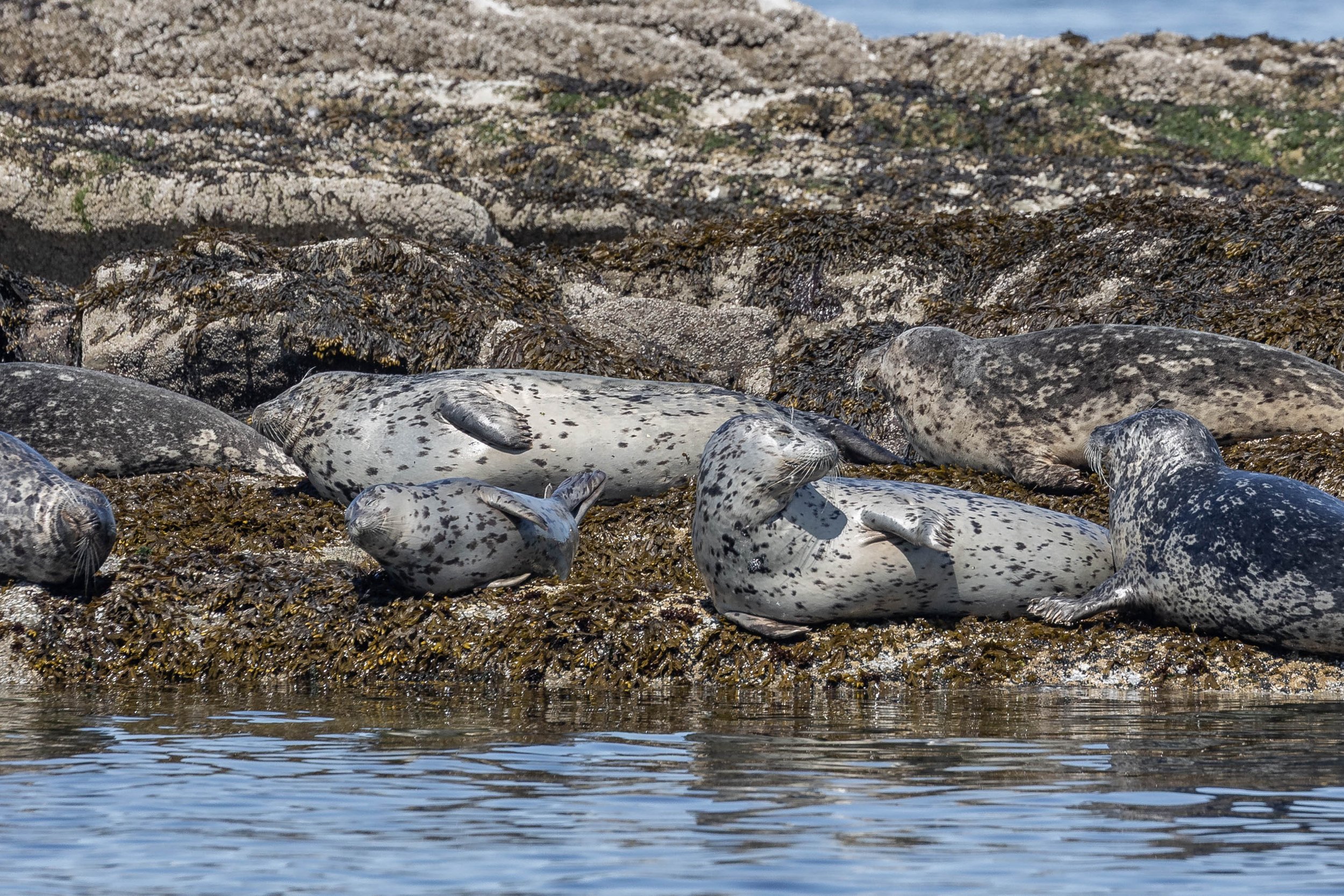May 4, 2025 - T019s and a different T049A brother - T049A1 Noah!
We had a classic moody West Coast day, with beautiful lighting that made for stunning photos! After leaving the dock, we headed south toward a report of orcas near Crofton. Since none of the whales are tagged, chipped, or tracked, we rely entirely on our eyes to find them each day. Shore reports like this give us a helpful starting point. We cruised through the well-known Dodd Narrows—a narrow passage only about 80 feet wide and nearly 70 feet deep. When the tides change, water can rush through at close to 9 knots, treating our guests to swirling whirlpools and mini rapids! From there, we slipped into Stuart Channel to see if we could spot any dorsal fins cutting through the water. Today, we got lucky. With three large males among the group, they were fairly easy to spot.
The whales we encountered today were:
T019 Nootka ♀ (~1965)
T019B Galiano ♂ (1995)
T019C Spouter ♂ (2001)
T049A1 Noah ♂ (2001)
T019B, also known as Galiano, is a local favourite thanks to his distinct, tall, and wide dorsal fin, which features a noticeable chip and a prominent lean. These characteristics make him easy to spot and identify. The lean in his dorsal fin is due to its size—it is considered "collapsed." In wild, transient orcas, dorsal fin collapse is relatively rare and not fully understood. It is often associated with age, stress, injury, illness, toxin exposure, or starvation. Some researchers suggest a genetic predisposition within certain matrilines, as some populations show higher rates of fin collapse. In older whales, weakened collagen can contribute to the structural failure of the fin. Stress—from environmental conditions, social dynamics, or injury—can also play a role. Physical trauma from interactions with other orca, boats, or marine debris may lead to damage and eventual collapse. Additionally, illness or underlying infections can weaken the fin tissue, and poor nutrition can degrade tissue integrity. Exposure to toxins such as crude oil has also been linked to dorsal fin collapse. While collapsed fins are far more common in captive orcas, they can occur in the wild. The phenomenon is still being studied by marine biologists, and the exact causes remain uncertain.
T049A1, also known as Noah, is a local favourite in our neck of the woods. He’s become a familiar fin around the marinas, often seen exploring them—likely in pursuit of harbour seals, which he seems to have mastered hunting in these areas. Noah is also fairly easy to identify thanks to his towering dorsal fin with a small notch, and a unique feature: a slight hunch in his back. This deformity may be genetic or the result of an old injury, but it doesn’t seem to affect his daily life!
After spending time with these familiar fins, we set out to meet more wildlife in the Salish Sea. One of the highlights was spotting more local favourites—harbour seals! These little cuties are hard not to love, with their sweet faces and endearing awkwardness on land. Because their hips are fused, they can’t walk on their flippers like sea lions; instead, they bounce along on their bellies. We were also lucky to see both species of sea lion. The smaller, chocolate-brown California Sea Lions were lounging on the log booms near Harmac Mill, a favourite hangout spot. The larger, sandy-brown Steller Sea Lions had hauled out on nearby rocks, another well-known gathering place. Interestingly, the California Sea Lions may have the better deal—the log booms rise and fall with the tides, while the rocks can be submerged, potentially leaving the Stellers exposed to hunting orca. We also caught sight of our iconic Bald Eagles—easily the most popular birds on our tours! It’s nesting season, so we expect to see fuzzy little eaglets popping their heads up in the nests very soon. Our final stop took us to the Gabriola bluffs, where cormorants are beginning to build their nests. These clever birds use their guano like cement to anchor nesting materials to the cliffs. We know how well it works—scrubbing it off the boats takes a lot of elbow grease!
Photos by Marine Naturalist Desarae Poier.
T049A1 Noah.
A great look at T049A1 Noah’s dorsal fin.
T049A1 Noah with a backlit blow.
T019B Galiano, can you see the lean to his fin?
T019C Spouter, his dorsal has a wave to it.
T019C Spouter a better look at that wavy dorsal.
T019 Nootka followed by T019C Spouter.
T019B Galiano with his brother T019C Spouter behind him.
Just the tip of T019B Galiano’s fin with T019C Spouter behind.
T019B Galiano with T019C Spouter in tow.
T019C Spouter.
Can you spot T019 Nootka beside T019C Spouter?
T019 Nootka with T019B Galiano following.
T019C Spouter’s wavy dorsal.
T019 Nootka.
A family photo!
T019 Nootka in the sun.
T019 Nootka and T019C Spouter following.
T019B Galiano.
T019C Spouter.
Harbour seals hauled out on the rocks.
Enjoying the sun.
A large male Steller Sea Lion making his way onto the rocks.
That is a lot of Stellers!
This male is probably close to 2000 pounds!
A good look at the fuzzy mane on this sea lion, that’s where the name comes from.
Harlequin ducks.
The males are the colourful ones and the females are brown.
I guess you can still have a “bad hair day” even when you’re bald.
The chocolate brown California Sea Lion.
Bonnie in her nest, hopefully sitting on some freshly hatched bald eaglets.
Most likely Clyde, Bonnies mate.
A proud Bonnie sitting tall.
Pelagic cormorants! Can you see the poop?
Double crested cormorants in their nest.



































